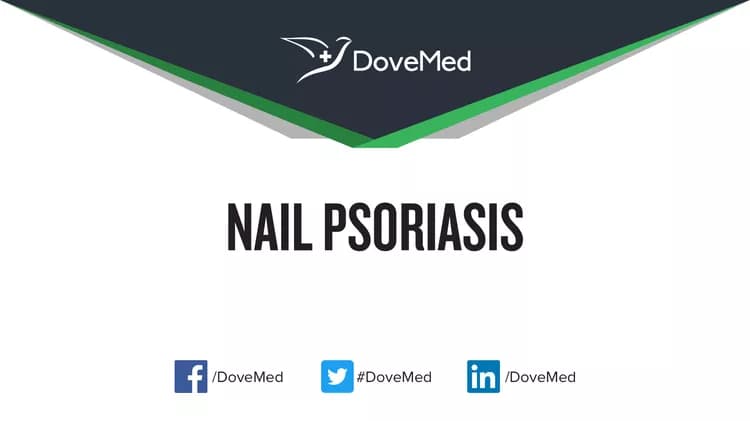What are the other Names for this Condition? (Also known as/Symptoms)
- Psoriasis of the Nails
- Psoriatic Nail Dystrophy
What is Nail Psoriasis? (Definition/Background Information)
- Nail Psoriasis is an uncommon subtype of psoriasis, which is a common chronic inflammatory skin disease that develops from a genetic defect. The condition causes the epidermis to grow abnormally, resulting in the formation of skin lesions. Psoriasis can run in families but is not a contagious condition
- In about 95% of the individuals, Nail Psoriasis is seen with other forms of psoriasis (mostly psoriasis vulgaris and psoriatic arthritis). In about 5% of the individuals, Nail Psoriasis is observed to be a “stand-alone” condition
- Nail Psoriasis is a chronic condition that affects the fingers and/or toes and is characterized by indentations/pitting on the nails, yellow discoloration, thickening of the nails, and nail loss. Either the entire nail or only a portion of the nail may be affected
- The signs and symptoms of Nail Psoriasis may get better and worse over a period of time. Over 50% of the individuals are also found to have psoriatic arthritis. The presentations may also vary from one individual to another and even within the same individual
- The treatment of Nail Psoriasis may involve the use of topical agents and corticosteroids for prolonged periods. Nevertheless, it is difficult to treat the condition. The use of phototherapy and systemic medication may be required.
- The prognosis of Nail Psoriasis depends upon its severity and response to treatment. However, it is a lifelong, persistent condition that needs to be regularly monitored and treated symptomatically. Severe cases of Nail Psoriasis can significantly affect one’s overall quality of life
Who gets Nail Psoriasis? (Age and Sex Distribution)
- Nail Psoriasis usually affects adults more than children; the condition may arise at any age
- Both males and females are affected
- The condition affects all races and ethnic groups
- Fair-skinned Caucasians have a generally higher prevalence rate for psoriasis, while dark-skinned individuals are affected to a lesser extent
What are the Risk Factors for Nail Psoriasis? (Predisposing Factors)
The following are the risk factors for Nail Psoriasis:
- Nail Psoriasis has a strong association with genetic factors. Studies have shown a correlation between psoriasis and individuals with certain types of human leukocyte antigens (HLAs). HLAs are gene complexes that form a part of the immune system
- Certain studies have also demonstrated that individuals with close relatives already affected by the condition are at a higher risk for the disease in comparison to the rest of the population. Hence, having a family member with psoriasis is a significant risk factor
- Presence of any subtype of psoriasis
- Caucasians, who are fair-skinned, are more susceptible to psoriasis
- HIV-infected patients are at an increased risk for the condition
- Individuals who are smokers, alcoholics, obese, diabetic, or with heart disease are at an increased risk for developing severe forms of the condition
- The symptoms may get worse during cold season - during fall and winter
It is important to note that having a risk factor does not mean that one will get the condition. A risk factor increases one’s chances of getting a condition compared to an individual without the risk factors. Some risk factors are more important than others.
Also, not having a risk factor does not mean that an individual will not get the condition. It is always important to discuss the effect of risk factors with your healthcare provider.
What are the Causes of Nail Psoriasis? (Etiology)
Nail Psoriasis may develop from an abnormal proliferation of the skin cells, referred to as keratinocytes. The origin of the condition is the nail matrix. The exact reason behind this development is unknown. However, it is believed to be influenced by certain genetic factors.
- There seems to be an association of the skin disorder with a dysfunctional immune system, which results in an abnormally rapid growth of epidermal cells
- The dysfunction is manifested only in the skin’s abnormal inflammatory response, not an increased risk of infections
- The genetic predisposition to develop psoriasis requires one or more of the many triggers to develop the same. Nail Psoriasis can be triggered by some external factors, especially trauma to the nail
What are the Signs and Symptoms of Nail Psoriasis?
The signs and symptoms of Nail Psoriasis can vary in type and severity from one individual to another. In some, the symptoms may be mild and involve only a few fingers and/or toes (partially at that), while in others, it can be severe, involving all parts of all fingers and toes. The severity of the condition varies from time to time.
- When psoriasis is present - in 1 in 2 cases, the fingernails are affected, while the toenails are affected in 1 in 3 cases
- Nail pitting and indentations are noticed initially
- Nail discoloration (yellowish) occurs from an accumulation of white blood cells beneath the nail termed an “oil drop”
- Thickening of nails develops that leads to detachment of the nail from the nail bed; scales develop beneath the nail surface
- The nails tend to mottle and crumble, giving it a distorted appearance
- Pain and burning sensation may be experienced
- Loss of partial or entire nail
- In addition to the above, the signs and symptoms of any of the other psoriasis subtypes (if present) may be noted
Psoriatic arthritis, affecting the hand, ankle, or knee joints with joint pain and inflammation, occurs in many individuals (in 50-80% of the cases) with Nail Psoriasis.
How is Nail Psoriasis Diagnosed?
If Nail Psoriasis is associated with any other variant of psoriasis, it is generally easy to diagnose the condition. If Nail Psoriasis is noted in isolation, then it can be mistaken for nail fungus (infection) and is more difficult to diagnose promptly
A diagnosis of Nail Psoriasis would involve the following tests and exams:
- Complete physical examination and comprehensive medical history (including evaluation of family history of the condition)
- Dermoscopy: It is a diagnostic tool where a dermatologist examines the skin using a special magnified lens
- X-rays, CT, and MRI scan of the affected joint can help reveal the extent of damage due to inflammation in individuals with psoriatic arthritis
- Culture of nail clippings or debris may help in ruling out bacterial or fungal infections
- Tissue biopsy: A tissue biopsy of the lesion may be performed and sent to a laboratory for a pathological examination. A pathologist examines the biopsy under a microscope. After putting together clinical findings, special studies on tissues (if needed), and microscope findings, the pathologist arrives at a definitive diagnosis
Many clinical conditions may have similar signs and symptoms. Your healthcare provider may perform additional tests to rule out other clinical conditions to arrive at a definitive diagnosis.
What are the possible Complications of Nail Psoriasis?
Nail Psoriasis can cause the following complications depending on the severity of the disease activity:
- Severe pain, tenderness, and irritation leading to acute discomfort and irritation
- Development of secondary bacterial or fungal infections
- In some individuals with pustular psoriasis, the condition can result in pustules (pus-formation) beneath the nail bed, leading to early nail loss
- The quality of one’s daily life (performing simple tasks, wearing footwear, etc.) may be affected
- Psychological issues, such as social anxiety, stress, low self-esteem, and depression, due to unsightly appearance of fingers and toes
- Due to its chronic nature, some individuals may undergo severe emotional issues and psychological distress that may require counseling
- Also, following nail loss, the nail that grows back (with treatment) may be significantly distorted or affected even more than the original nail
- Medication side effects from treatment
How is Nail Psoriasis Treated?
Nail Psoriasis is incurable with currently available treatment measures. The goal behind the treatment is to help control the symptoms, prevent skin infections, and avoid long-term complications. The condition has generally been refractory to therapy.
In general, the following medication/treatment methods are used to manage Nail Psoriasis:
- Mild conditions are treated topically by using recommended lotions, creams, or by taking steroids to help reduce or control the associated symptoms
- These include high-strength corticosteroids, 5-fluorouracil cream or solution, and calcipotriol (vitamin D) solution
- Such creams and lotions may have to be applied for several months and even years
- However, it has to be noted that topical applications are not known to be effective in treating the nail condition
- The following treatment measures are known to be beneficial:
- Phototherapy (PUVA or UVB)
- Use of systemic retinoids
- Immunosuppressive drugs such as methotrexate and cyclosporine
- Intralesional injections of corticosteroids (painful)
- Biological therapy: With the advent of biologic therapy, Nail Psoriasis has been shown to clear more readily
- Antifungal medication for treating any fungal infection, if present
- Rarely, surgical procedures to remove severely affected nails may be recommended
Medications can have significant side effects. Besides, since the medications are often needed for a long duration of time, it is recommended that combinations of medications be used to reduce side effects. This is known as rotational therapy.
How can Nail Psoriasis be Prevented?
Currently, there are no preventative measures available for Nail Psoriasis since it is a genetic condition. Ensuring proper self-care and regular healthcare visits are helpful in mitigating the severity and discomfort.
- Avoiding trauma (or the application of too much pressure on the nail) can help prevent aggravation of the condition
- Avoid exposure to cold temperatures for prolonged periods
- Avoid triggers to the condition such as smoking, drinking alcohol, and weight gain
Active research is currently being performed to explore the possibilities for treatment and prevention of inherited and acquired genetic conditions.
What is the Prognosis of Nail Psoriasis? (Outcomes/Resolutions)
The prognosis for Nail Psoriasis depends on the extent of the condition and severity of signs and symptoms. It is generally good to excellent for mild cases.
- It is reported that in some rare cases, Nail Psoriasis resolves spontaneously or following prolonged and effective treatment
- In severe cases, the prognosis depends on the set of signs and symptoms. Severe disease can significantly affect one’s quality of overall life and result in long-term stress and depression since Nail Psoriasis symptoms may frequently recur and persist for years
- The nail condition can last a lifetime if left untreated. If indicated for other aspects of psoriasis or psoriatic arthritis, Nail Psoriasis can be improved with modern therapy
Additional and Relevant Useful Information for Nail Psoriasis:
- There is no evidence to prove that oily foods and chocolate-based products have an influence on the development of this condition
- Cleaning the skin too hard with strong chemicals or soaps may aggravate the skin condition. Care must be taken to avoid strong soaps and chemicals that could potentially worsen the condition
- The presence of dirt on the body is not a causative factor for the condition. However, it helps to be clean and hygienic, which may help prevent the condition from getting worse
Related Articles
Test Your Knowledge
Asked by users
Related Centers
Related Specialties
Related Physicians
Related Procedures
Related Resources
Join DoveHubs
and connect with fellow professionals



0 Comments
Please log in to post a comment.